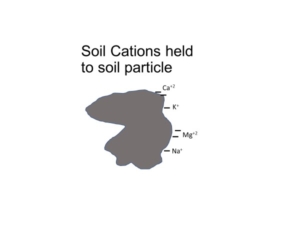Estimating soil texture with cation exchange capacity (CEC)
Soil texture is a basic physical soil property that describes the proportion of sand-, silt-, and clay-sized particles in soil. It controls the ability of soil to retain water and nutrients and the movement of water and nutrients through the soil profile. Soil texture is a fundamental soil property, but measuring soil texture requires time-consuming and expensive laboratory analysis procedures. An alternative option is estimating soil texture from cation exchange capacity (CEC), which is a rapid, routine procedure in commercial soil analysis.
 Cation exchange capacity is the amount of positive-charged cations (e.g. ammonium, calcium, hydrogen, magnesium, potassium, sodium) held on negative-charged soil particles, like clay and organic matter. Since soil texture and CEC are intimately related, we can use each soil property to make predictions about the other. Soils with more large soil particles are coarse-textured (sandy), whereas soils with more small soil particles are fine-textured (clayey). Each soil particle has some surface area, which controls the CEC. Fine-textured soils have more soil particle surface area, so their CEC is greater (Table 1).
Cation exchange capacity is the amount of positive-charged cations (e.g. ammonium, calcium, hydrogen, magnesium, potassium, sodium) held on negative-charged soil particles, like clay and organic matter. Since soil texture and CEC are intimately related, we can use each soil property to make predictions about the other. Soils with more large soil particles are coarse-textured (sandy), whereas soils with more small soil particles are fine-textured (clayey). Each soil particle has some surface area, which controls the CEC. Fine-textured soils have more soil particle surface area, so their CEC is greater (Table 1).
| Table 1. Estimating soil texture from cation exchange capacity (CEC). | |||
| Cation exchange capacity (CEC), cmolc/kg | Soil organic matter, % | Particle size family | Soil texture class |
| ≤10 | <20 | coarse | sandy |
| 11-20 | <20 | medium | coarse loam |
| 21-30 | <20 | medium | fine loam |
| >30 | <20 | fine | clayey |
| — | >20 | organic | peat or muck |
The soil texture estimation procedure is valid on soils with pH < 7.3 and no salinity. For soils with high pH or salinity, analytical challenges in routine laboratory CEC determination make soil texture estimation inaccurate.
